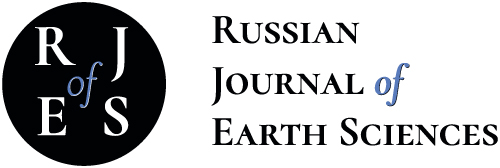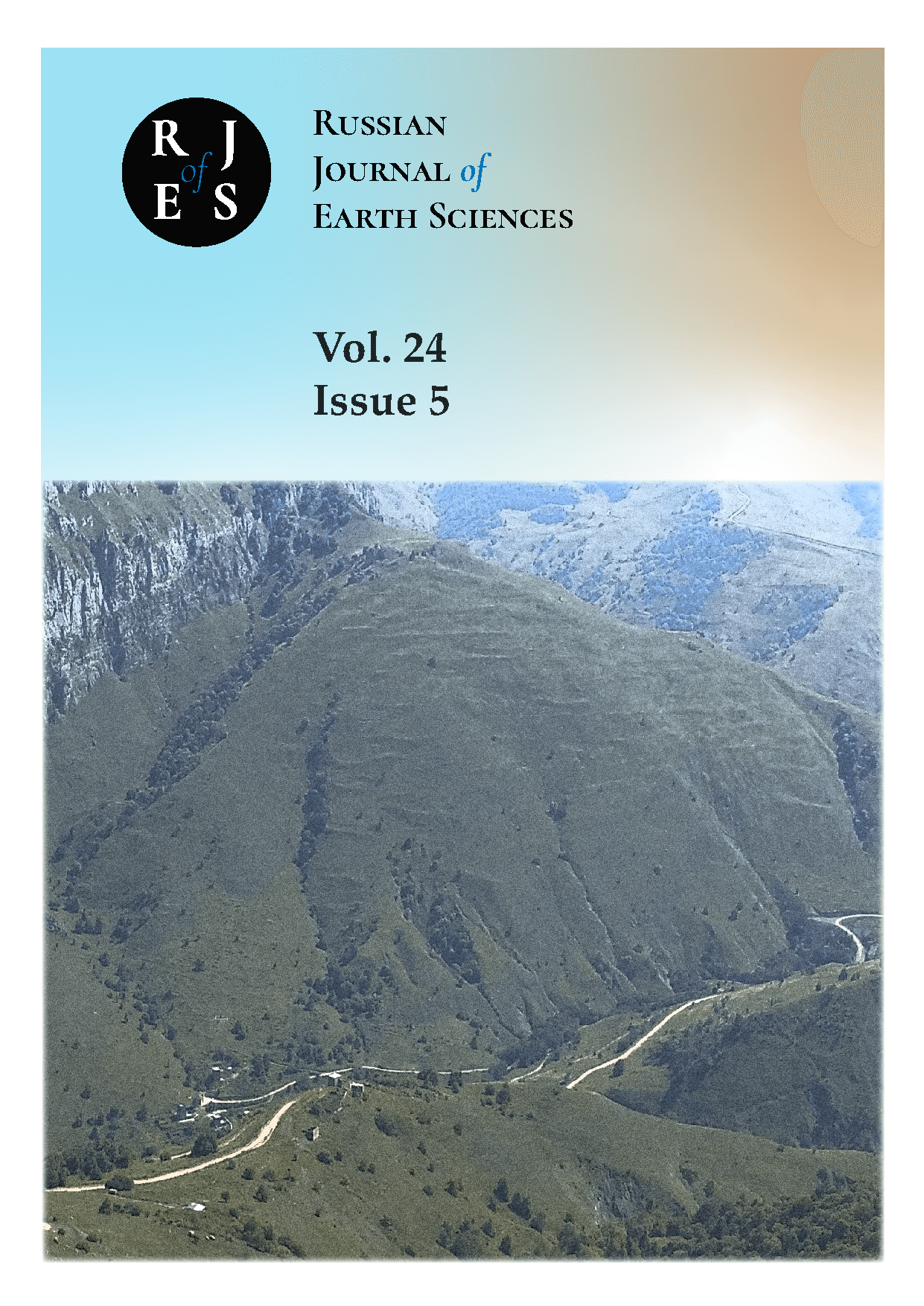Moscow Institute of Physics and Technology (State University)
Moscow, Russian Federation
Russian Federation
Moscow Institute of Physics and Technology (State University)
Russian Federation
Institute of Geology of Ore Deposits Petrography Mineralogy and Geochemistry
Russian Federation
Russian Federation
UDC 55
UDC 550.34
UDC 550.383
CSCSTI 37.01
CSCSTI 37.15
CSCSTI 37.25
CSCSTI 37.31
CSCSTI 38.01
CSCSTI 36.00
CSCSTI 37.00
CSCSTI 38.00
CSCSTI 39.00
CSCSTI 52.00
Russian Classification of Professions by Education 05.00.00
Russian Library and Bibliographic Classification 26
Russian Trade and Bibliographic Classification 63
BISAC SCI SCIENCE
Intensification of mining activities often lead to nucleation of strong earthquakes and fault-slip bursts in areas that were previously thought to be aseismic or of low seismicity. Triggering strong seismic events associates with slips on existing tectonic faults and large fractures, whose structures essentially alter along strike. This work analyzes parameters of mine seismicity at the Korobkovskoye iron ore deposit, within which the large North-Eastern fault is localized. The goal of this analysis is to assess the probability of triggering strong seismic events at the fault segments with different structures of the core. The technique of ripple-fired blasting and horizon mining are employed in developing the deposit. This provokes weak seismic activity within the mine field. When explosions are hold in host rock, seismic events localize within the blasted chamber. The magnitude statistics displays distribution that obeys a power law, and the scaling exponent 𝑏-value, as a rule, is less than 2. When explosions are hold in the vicinity of the fault, seismic events localize along its trace, and the 𝑏-value, as a rule, exceeds 2. The main feature of seismicity at the Korobkovskoye iron ore deposit is that the induced events are of low radiative efficiency of 8,9 × 10−9–4,9 × 10−7 J/(N·m), which corresponds to “slow earthquakes”. The core of the North-Eastern fault contains mainly velocity-strengthening rocks, causing initiation of slow slip events. It is this circumstance that probably determines initiation of slow events. Linking the data of seismic monitoring and the structural and rheological properties of materials that compose the fault core allows to suggest that within the mine field in the vicinity of the North-Eastern fault the accumulated deformations can release mainly via slow and aseismic slips.
slow earthquakes, velocity strengthening, mine seismicity, tectonic fault, seismic monitoring
1. Adushkin V. V. Technogenic tectonic seismicity in Kuzbass // Russian Geology and Geophysics. — 2018. — Vol. 59, no. 5. — P. 571–583. — DOI:https://doi.org/10.1016/j.rgg.2018.04.010.
2. Arrowsmith S. J., Arrowsmith M. D., Hedlin M. A. H., et al. Discrimination of Delay-Fired Mine Blasts in Wyoming Using an Automatic Time-Frequency Discriminant // Bulletin of the Seismological Society of America. — 2006. — Vol. 96, no. 6. — P. 2368–2382. — DOI:https://doi.org/10.1785/0120060039.
3. Besedina A. N., Kishkina S. B., Kocharyan G. G., et al. Weak Induced Seismicity in the Korobkov Iron Ore Field of the Kursk Magnetic Anomaly // Journal of Mining Science. — 2020. — Vol. 56, no. 3. — P. 339–350. — DOI:https://doi.org/10.1134/S1062739120036818.
4. Bolton D. C., Shokouhi P., Rouet-Leduc B., et al. Characterizing Acoustic Signals and Searching for Precursors during the Laboratory Seismic Cycle Using Unsupervised Machine Learning // Seismological Research Letters. — 2019. — Vol. 90, no. 3. — P. 1088–1098. — DOI:https://doi.org/10.1785/0220180367.
5. Boulton C., Carpenter B. M., Toy V., et al. Physical properties of surface outcrop cataclastic fault rocks, Alpine Fault, New Zealand // Geochemistry, Geophysics, Geosystems. — 2012. — Vol. 13, no. 1. — DOI:https://doi.org/10.1029/2011GC003872.
6. Brune J. N. Tectonic stress and the spectra of seismic shear waves from earthquakes // Journal of Geophysical Research. — 1970. — Vol. 75, no. 26. — P. 4997–5009. — DOI:https://doi.org/10.1029/JB075i026p04997.
7. Buijze L., Guo Y., Niemeijer A. R., et al. Effects of heterogeneous gouge segments on the slip behavior of experimental faults at dm scale // Earth and Planetary Science Letters. — 2021. — Vol. 554. — P. 116652. — DOI:https://doi.org/10.1016/j.epsl.2020.116652.
8. Carpinteri A., Xu J., Lacidogna G., et al. Reliable onset time determination and source location of acoustic emissions in concrete structures // Cement and Concrete Composites. — 2012. — Vol. 34, no. 4. — P. 529–537. — DOI:https://doi.org/10.1016/j.cemconcomp.2011.11.013.
9. Chalumeau C., Agurto-Detzel H., Rietbrock A., et al. Seismological evidence for a multifault network at the subduction interface // Nature. — 2024. — Vol. 628, no. 8008. — P. 558–562. — DOI:https://doi.org/10.1038/s41586-024-07245-y.
10. Chester F. M., Chester J. S., Kirschner D. L., et al. 8. Structure of Large-Displacement, Strike-Slip Fault Zones in the Brittle Continental Crust // Rheology and Deformation of the Lithosphere at Continental Margins. — Columbia University Press, 2004. — P. 223–260. — DOI:https://doi.org/10.7312/karn12738-009.
11. Collettini C., Barchi M. R., De Paola N., et al. Rock and fault rheology explain differences between on fault and distributed seismicity // Nature Communications. — 2022. — Vol. 13, no. 1. — DOI:https://doi.org/10.1038/s41467-022-33373-y.
12. Collettini C., Tesei T., Scuderi M. M., et al. Beyond Byerlee friction, weak faults and implications for slip behavior // Earth and Planetary Science Letters. — 2019. — Vol. 519. — P. 245–263. — DOI:https://doi.org/10.1016/j.epsl.2019.05.011.
13. Dieterich J. H. Modeling of rock friction: 1. Experimental results and constitutive equations // Journal of Geophysical Research: Solid Earth. — 1979. — Vol. 84, B5. — P. 2161–2168. — DOI:https://doi.org/10.1029/JB084iB05p02161.
14. Dixon N., Smith A., Flint J. A., et al. An acoustic emission landslide early warning system for communities in low-income and middle-income countries // Landslides. — 2018. — Vol. 15, no. 8. — P. 1631–1644. — DOI:https://doi.org/10.1007/s10346-018-0977-1.
15. Emanov A. F., Emanov A. A., Fateev A. V., et al. The technogenic Bachat earthquake of June 18, 2013 (ML = 6.1) in the Kuznetsk Basin-the world’s strongest in the extraction of solid minerals // Seismic Instruments. — 2017. — Vol. 53, no. 4. — P. 333–355. — DOI:https://doi.org/10.3103/S0747923917040041.
16. Fagereng A. and Sibson R. H. Mélange rheology and seismic style // Geology. — 2010. — Vol. 38, no. 8. — P. 751–754. — DOI:https://doi.org/10.1130/G30868.1.
17. Foulger G. R., Wilson M. P., Gluyas J. G., et al. Global review of human-induced earthquakes // Earth-Science Reviews. — 2018. — Vol. 178. — P. 438–514. — DOI:https://doi.org/10.1016/j.earscirev.2017.07.008.
18. Gibowicz S. J. and Kijko A. Introduction to Mining Seismology / ed. by R. Dmowska. — Elsevier Science & Technology Books, 2013.
19. Gilyarov V. L., Damaskinskaya E. E., Kadomtsev A. G., et al. Analysis of statistic parameters of geoacoustic monitoring data for the Antey uranium deposit // Journal of Mining Science. — 2014. — Vol. 50, no. 3. — P. 443–447. — DOI:https://doi.org/10.1134/S1062739114030065.
20. Gridin G. A., Ostapchuk A. A., Grigorieva A. V., et al. Variations in the structural and physical-mechanical properties of a tectonic fault in the near-surface zone // Izvestiya, Physics of the Solid Earth. — 2025. — No. 1. — In press.
21. Hanks T. C. and Kanamori H. A moment magnitude scale // Journal of Geophysical Research: Solid Earth. — 1979. — Vol. 84, B5. — P. 2348–2350. — DOI:https://doi.org/10.1029/JB084iB05p02348.
22. Ikari M. J., Marone Ch. and Saffer D. M. On the relation between fault strength and frictional stability // Geology. — 2011. — Vol. 39, no. 1. — P. 83–86. — DOI:https://doi.org/10.1130/g31416.1.
23. Kanamori H. The energy release in great earthquakes // Journal of Geophysical Research. — 1977. — Vol. 82, no. 20. — P. 2981–2987. — DOI:https://doi.org/10.1029/JB082i020p02981.
24. Keilis-Borok V. I. Study of the mechanism of earthquakes. — Moscow : USSR Academy of Sciences, 1957. — P. 148.
25. Kocharyan G. G. Geomechanics of faults. — Moscow : GEOS, 2016. — P. 432.
26. Kocharyan G. G., Besedina A. N., Gridin G. A., et al. Friction as a Factor Determining the Radiation Efficiency of Fault Slips and the Possibility of Their Initiation: State of the Art // Izvestiya, Physics of the Solid Earth. — 2023. — No. 59. — P. 337–363. — DOI:https://doi.org/10.1134/S1069351323030060.
27. Kocharyan G. G., Budkov A. M. and Kishkina S. B. Initiation of Tectonic Earthquakes during Underground Mining // Journal of Mining Science. — 2018a. — Vol. 54, no. 4. — P. 561–568. — DOI:https://doi.org/10.1134/S1062739118044014.
28. Kocharyan G. G., Kulikov V. I. and Pavlov D. V. On the influence of mass explosions on the stability of tectonic faults // Physical and technical problems of mineral development. — 2019. — No. 6. — DOI:https://doi.org/10.15372/FTPRPI20190605.
29. Kocharyan G. G., Ostapchuk A. A., Pavlov D. V., et al. The Effects of Weak Dynamic Pulses on the Slip Dynamics of a Laboratory Fault // Bulletin of the Seismological Society of America. — 2018b. — Vol. 108, 5B. — P. 2983–2992. — DOI:https://doi.org/10.1785/0120170363.
30. Kocharyan G. G., Qi Ch., Kishkina S., et al. Potential triggers for large earthquakes in open-pit mines: A case study from Kuzbass, Siberia // Deep Underground Science and Engineering. — 2022. — Vol. 1, no. 2. — P. 101–115. — DOI:https://doi.org/10.1002/dug2.12028.
31. Kwiatek G., Plenkers K. and Dresen G. Source Parameters of Picoseismicity Recorded at Mponeng Deep Gold Mine, South Africa: Implications for Scaling Relations // Bulletin of the Seismological Society of America. — 2011. — Vol. 101, no. 6. — P. 2592–2608. — DOI:https://doi.org/10.1785/0120110094.
32. Lavrov A. V. and Shkuratnik V. L. Deformation- and fracture-induced acoustic emission in rocks (review) // Akusticeskij Zurnal. — 2005. — Vol. 51. — P. 6–18. — EDN: https://elibrary.ru/HSIMXL.
33. Li B., Li N., Wang E., et al. Discriminant Model of Coal Mining Microseismic and Blasting Signals Based on Waveform Characteristics // Shock and Vibration. — 2017. — Vol. 2017. — P. 1–13. — DOI:https://doi.org/10.1155/2017/6059239.
34. Lobatskaya P. M. Zones of dynamic influence of faults based on the analysis of associated ruptures // Geology and Geophysics. — 1983. — No. 6. — P. 53–61.
35. Locchi M. E., Scognamiglio L., Tinti E., et al. A large fault partially reactivated during two contiguous seismic sequences in Central Italy: The role of geometrical and frictional heterogeneities // Tectonophysics. — 2024. — Vol. 877. — P. 230284. — DOI:https://doi.org/10.1016/j.tecto.2024.230284.
36. Lovchikov A. V. Review of the strongest rockbursts and mining-induced earthquakes in Russia // Journal of Mining Science. — 2013. — Vol. 49, no. 4. — P. 572–575. — DOI:https://doi.org/10.1134/S1062739149040072.
37. Lu C.-P., Liu Y., Zhang N., et al. In-situ and experimental investigations of rockburst precursor and prevention induced by fault slip // International Journal of Rock Mechanics and Mining Sciences. — 2018. — Vol. 108. — P. 86–95. — DOI:https://doi.org/10.1016/j.ijrmms.2018.06.002.
38. Ma J., Zhao G., Dong L., et al. A Comparison of Mine Seismic Discriminators Based on Features of Source Parameters to Waveform Characteristics // Shock and Vibration. — 2015. — Vol. 2015. — P. 1–10. — DOI:https://doi.org/10.1155/2015/919143.
39. Morozova K. G., Ostapchuk A. A., Besedina A. N., et al. Classification of seismic events accompanying the blasting method of mining // Seismicheskie Pribory. — 2022. — Vol. 58, no. 4. — P. 97–110. — DOI:https://doi.org/10.21455/si2022.4-6.
40. Oparin V. N., Usol’tseva O. M., Semenov V. N., et al. Evolution of stress-strain state in structured rock specimens under uniaxial loading // Journal of Mining Science. — 2013. — Vol. 49, no. 5. — P. 677–690. — DOI:https://doi.org/10.1134/S1062739149050018.
41. Ostapchuk A., Morozova K., Markov V., et al. Acoustic Emission Reveals Multiple Slip Modes on a Frictional Fault // Frontiers in Earth Science. — 2021. — Vol. 9. — DOI:https://doi.org/10.3389/feart.2021.657487.
42. Oye V. Source Parameters and Scaling Relations for Mining-Related Seismicity within the Pyhasalmi Ore Mine, Finland // Bulletin of the Seismological Society of America. — 2005. — Vol. 95, no. 3. — P. 1011–1026. — DOI:https://doi.org/10.1785/0120040170.
43. Patonin A. V., Shikhova N. M., Ponomarev A. V., et al. Module system of continuous acoustic emission registration for laboratory studies of the rocks destruction processes // Sejsmicheskie pribory. — 2018. — Vol. 54, no. 3. — P. 35–55. — DOI:https://doi.org/10.21455/si2018.3-3.
44. Richardson E. Seismicity in Deep Gold Mines of South Africa: Implications for Tectonic Earthquakes // Bulletin of the Seismological Society of America. — 2002. — Vol. 92, no. 5. — P. 1766–1782. — DOI:https://doi.org/10.1785/0120000226.
45. Scholz C. H. Large Earthquake Triggering, Clustering, and the Synchronization of Faults // Bulletin of the Seismological Society of America. — 2010. — Vol. 100, no. 3. — P. 901–909. — DOI:https://doi.org/10.1785/0120090309.
46. Shebalin P. N., Gvishiani A. D., Dzeboev B. A., et al. Why Are New Approaches to Seismic Hazard Assessment Required? // Doklady Earth Sciences. — 2022. — Vol. 507, no. 1. — P. 930–935. — DOI:https://doi.org/10.1134/s1028334x22700362.
47. Sherman C. I., Bornyakov C. A. and Buddo B. Yu. Regions of dynamic influence of faults. — Novosibirsk : Science, 1983. — P. 112.
48. Shkuratnik V. L. and Voznesensky A. S. Acoustic emission of the ultrasonic frequency range as a tool for solving problems of mining geophysics // Mining Journal. — 2009. — No. 1. — P. 54–57. — EDN: https://elibrary.ru/LHOUDT.
49. Sibson R. H. Thickness of the Seismic Slip Zone // Bulletin of the Seismological Society of America. — 2003. — Vol. 93, no. 3. — P. 1169–1178. — DOI:https://doi.org/10.1785/0120020061.
50. Smirnov V. B., Ponomarev A. B. and Zavyalov A. D. Structure of the acoustic regime in rock samples and seismic regime // Izvestiya, Physics of the Solid Earth. — 1995. — No. 1. — P. 38–58. — EDN: https://elibrary.ru/XGWLWZ.
51. Smith S. A. F., Bistacchi A., Mitchell T. M., et al. The structure of an exhumed intraplate seismogenic fault in crystalline basement // Tectonophysics. — 2013. — Vol. 599. — P. 29–44. — DOI:https://doi.org/10.1016/j.tecto.2013.03.031.
52. Tinti E., Casarotti E., Ulrich T., et al. Constraining families of dynamic models using geological, geodetic and strong ground motion data: The Mw 6.5, October 30th, 2016, Norcia earthquake, Italy // Earth and Planetary Science Letters. — 2021. — Vol. 576. — P. 117237. — DOI:https://doi.org/10.1016/j.epsl.2021.117237.
53. Volpe G., Pozzi G. and Collettini C. Y-B-P-R or S-C-C’? Suggestion for the nomenclature of experimental brittle fault fabric in phyllosilicate-granular mixtures // Journal of Structural Geology. — 2022. — Vol. 165. — P. 104743. — DOI:https://doi.org/10.1016/j.jsg.2022.104743.
54. Vostrikov V. I., Usol’tseva O. M., Tsoi P. A., et al. Deformation processes features and microseismic emission of rock speciments under loadinguntil failure // Interexpo Geo-Siberia. — 2016. — Vol. 2, no. 3. — P. 45–49. — EDN: https://elibrary.ru/VXLLAX.
55. Walsh F. R. and Zoback M. D. Probabilistic assessment of potential fault slip related to injection-induced earthquakes: Application to north-central Oklahoma, USA // Geology. — 2016. — Vol. 44, no. 12. — P. 991–994. — DOI:https://doi.org/10.1130/G38275.1.
56. Wiemer S. A Software Package to Analyze Seismicity: ZMAP // Seismological Research Letters. — 2001. — Vol. 72, no. 3. — P. 373–382. — DOI:https://doi.org/10.1785/gssrl.72.3.373.
57. Zakharov V. N. Seismoacoustic forecasting and control of the state and properties of rocks in the development of coal deposits. — Moscow : IGD im. A. A. Skochinsky, 2002. — P. 172.
58. Zmushko T. Yu., Turuntaev S. B. and Kulikov V. I. Relationship between mine seismicity and the mining regime in the Vorkuta mines // Dynamic processes in the geospheres. — 2011. — No. 2. — P. 75–88. — EDN: https://elibrary.ru/TMYUCR.















